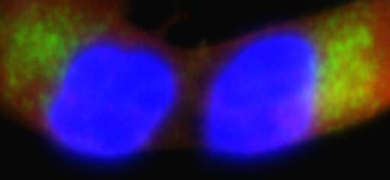
Transfection reagents allow scientists to manipulate the genetic material of cells by introducing exogenous nucleic acids sequences. While transfection is commonly used to alter gene expression in cell biology experiments, advanced gene editing methods such as CRISPR/Cas 9 rely on transfection to successfully introduce nucleases and guide RNA into the host cell. Lipid-based transfection reagents are most effective in actively proliferating cells and are valuable for a variety of applications, including protein expression and the overexpression of mutant genes. ATCC’s transfection reagents are cationic lipid-based; because of their positive charge, these reagents interact with the negatively charged backbone of nucleic acids and cell membranes. Cationic lipid transfection is a fast, simple, and reproducible process for introducing DNA, RNA, or other oligonucleotides into eukaryotic cells. This classic method offers highly efficient transfection for a broad range of cell types, including adherent and suspension cell lines, as well as many primary cells and stem cells. Our exceptional transfection reagents, combined with ATCC's technical know-how, will enable your transcriptional and translational gene studies.
Cationic lipids have become the tool of choice for many researchers. ATCC’s line of transfection reagents, GeneXPlus and TransfeX are tailored for effective nucleic acid transfer into a wide variety of cells for a multitude of applications, including:
|
|
|
|
|
|
|
|
|
|
|
|
ATCC cells have been a key component of genetic research applications for decades. ATCC offers a line of transfection reagents tailored for effective nucleic acid transfer into a wide variety of cells for a multitude of applications. We have optimized several protocols using GeneXPlus and/or TransfeX for transfection. Click on the ATCC cell line to obtain the protocols.
Select the transfection reagent for your model system below.
GeneXPlus provides high transfectability in suspension cell cultures.
GeneXPlus Transfection Reagent is designed to efficiently transfect a broad spectrum of cell types. GeneXPlus displays high transfection efficiency with low cytotoxicity in suspension cells such as HEK-293T/SF and THP-1, as well as difficult-to-transfect cell lines such as RAW 264.7 and SH-SY5Y.
| THP-1 (ATCC TIB-202) | BJ-5ta (ATCC CRL-4001) |
| RAW 264.7 (ATCC TIB-71) | Uterine Smooth Muscle Cells (ATCC PCS-460-011) |
| SH SY5Y (ATCC CRL-2266) | TeloHAEC (ATCC CRL-4052) |
| MRC-5 (ATCC CCL-171) | Bone Marrow-derived Mesenchymal Stem Cells (ATCC PCS-500-012) |
TransfeX ideal for adherent cultures with tailored transfection protocols for hard-to-transfect cells.
TransfeX Transfection Reagent has been optimized for use on a wide range of cell types, including cells that are generally difficult to transfect, such as hTERT immortalized cell lines, primary cells, and stem cells. TransfeX has been optimized for high transfection efficiency and low cytotoxicity, with reliability and scalability.
| 3T3-L1 (ATCC CL-173) | Bone-marrow derived MSCs (ATCC PCS-500-012) |
| Caco-2 (ATCC HTB-37) | HMECs (ATCC PCS-600-010) |
| C2C12 (ATCC CRL-1772) | Bronchial/Tracheal Epithelial Cells (ATCC PCS-300-010) |
| CHO-K1 (ATCC CCL-61) | Dermal Fibroblasts (ATCC PCS-201-012) |
| HepG2 (ATCC HB-8065) | Dermal Microvascular Endothelial Cells (ATCC PCS-110-010) |
| LNCap(FGC) (ATCC CRL-1740) | Mammary Epithelial Cells (ATCC PCS-600-010) |
| MCF7 (ATCC HTB-22) | Renal Proximal Tubule Endothelial Cells (ATCC PCS-400-010) |
| MDA-MB-231 (ATCC HTB-26) | Umbilical Vein Endothelial Cells (ATCC PCS-100-010) |
| NuLi-1 (ATCC CRL-4011) | Renal Proximal Tubule Endothelial Cells/TERT1 (ATCC CRL-4031) |
| TIME (ATCC CRL-4025) | hiPSCs (ATCC Nos. ACS-1003, -1004, -1007, -1011, -1012, -1013, -1014, -1019, -1020, -1021) |
